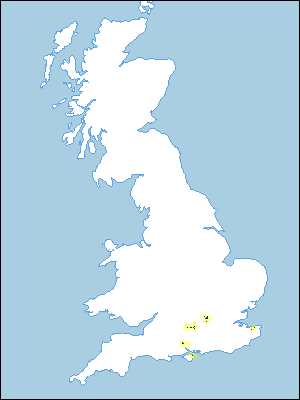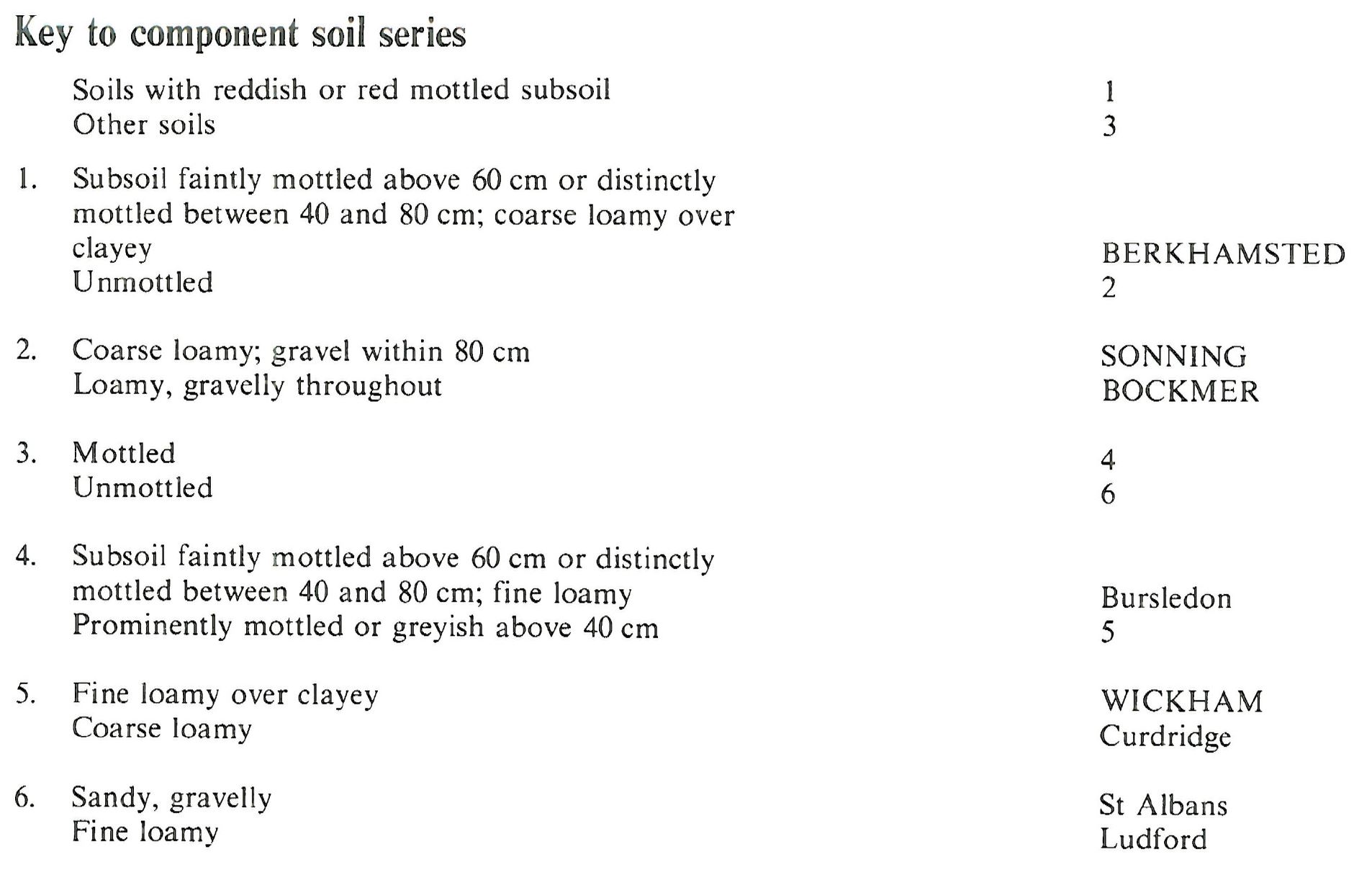
Soil Associations
0581c SONNING 2
Soil and site characteristics
Well drained flinty coarse loamy and gravelly soils. Associated with slowly permeable seasonally waterlogged fine loamy over clayey soils, and coarse loamy over clayey soils with slowly permeable subsoils and slight seasonal waterlogging.
Geology
Plateau and river terrace drift
Cropping and Land Use
Grassland with dairying and cereals; deciduous and coniferous woodland.
Component soil series
| Subgroup | Series name | Percentage | WRB 2006 link |
|---|---|---|---|
| 5.81 | SONNING | 40% | Chromic Endoskeletic Luvisols |
| 7.11 | WICKHAM | 20% | Eutric Luvic Planosols |
| 5.82 | BERKHAMSTED | 10% | Abruptic Chromic Endostagnic Luvisols |
| 5.81 | BOCKMER | 10% | Ruptic Chromic Skeletic Luvisols |
Covers 137 km2 in England and Wales
Soilscapes Classification
| 6 |
Freely draining slightly acid loamy soils |
0581c SONNING 2
Detailed Description
The soils in this association are developed in pre-Devensian gravelly Plateau and river terrace drift which has been strongly disturbed by periglacial processes and overlies the Chalk, Reading Beds and, locally, London Clay. The association is most extensive along the Thames valley between Uxbridge and Maidenhead, and in the Kennet valley between Reading and Newbury. The largest area is north of Slough. Similar drift is present in Hampshire and on the Isle of Wight. There are small patches over Tertiary strata in the Test and Itchen valleys north of Southampton, and over Bembridge Marls and Hamstead Beds between Cowes and Bembridge. Most of the land is level or gently sloping and below 120 m O.D.
Sonning soils, reddish, flinty coarse loamy over gravelly typical paleo-argillic brown earths, are dominant with small patches of similar but loamy gravelly Bockmer soils locally. Seasonally waterlogged fine loamy or fine silty over clayey Wickham series , typical stagnogley soils, are widely distributed around valley margins and in small hollows where drift thins over Tertiary strata. Coarse loamy over clayey Berkhamsted soils, stagnogleyic paleo-argillic brown earths, are found where the Plateau Drift contains red and greyish mottled clay mainly derived from Reading Beds.
The soil pattern is often complex with little change in relief. Near Chalfont St Giles, on level and gently sloping land, the variation in soil water regime and substrate type is large. Shallow valleys crossing this land have flinty fine loamy Ludford soils in thick drift. In Berkshire, the association occurs mainly on agricultural land and is replaced on heathland and in woodland by the Southampton association. Seasonally waterlogged coarse loamy Curdridge and fine loamy Bursledon soils occur with Wickham soils on slopes below the terrace flats.
The association is found in Hampshire on river terraces along the Itchen and Test where they cross Reading Beds and London Clay north of Southampton. The main soils are Sonning and Bockmer series on flat land; Wickham and the similar but coarse loamy over clayey Kings Newton series occur mainly on slopes between terraces. Breamore soils are present occasionally in hollows. The soil pattern on the Isle of Wight differs. Here, Sonning soils are usually dominant but Bockmer soils are the most common associate. Berkhamsted soils are developed in flinty coarse loamy over clayey drift and are locally dominant. Wickham soils are less extensive then elsewhere and are confined to slopes. Wet, fine loamy Shabbington soils occur in narrow strips of thick drift near streams.
Soil Water Regime
Sonning and Bockmer soils are permeable and well drained (Wetness Class I). Berkhamsted soils are occasionally or seasonally waterlogged (Wetness Class II or III) because the clayey subsoil is moderately permeable. Wickham soils have slowly permeable subsoils and are seasonally waterlogged (Wetness Class IV). The land readily accepts winter rain and there is little surface run-off. Reserves of water in Sonning and Bockmer soils are small and all crops suffer moderately or severely from drought in most years; cereal crops grown on Wickham and Berkhamsted soils are only slightly affected.
Cropping and Land Use
The land is used mainly for dairy farming so most is under grass. Risk of poaching is small on land with Sonning and Bockmer soils, but is greater on Berkhamsted and on Wickham soils. Yields of grass on the droughty Sonning and Bockmer soils are below average but the long grazing season allows flexible use of the land. Sonning and Bockmer soils are easy to cultivate and some cereals are grown. Precision drilled crops are not favoured because of stoniness. The stones also increase wear on tyres and implements, and make machine-harvesting of root crops difficult. Even with drainage improvements, Wickham soils remain wet and difficult to cultivate, and autumn ploughing is essential, but with careful management good crops of cereals and oilseed rape can be grown.
Broad-leaved and coniferous woodlands are widespread. The former commonly consist of overgrown sweet chestnut or hornbeam coppice with oak or beech standards. Many deciduous woodlands have been felled and replanted with conifers such as Corsican pine, Norway spruce, larch, Douglas fir or western hemlock. On very acid soils, the choice is restricted to Scots or Corsican pine and Douglas fir. Wickham soils are severely damaged by traffic if felling is carried out in wet seasons. Much of the woodland is accessible to the public; Burnham Beeches, north of Slough, is partly on this association. Footpaths on Sonning and Bockmer soils are easily eroded and those on Wickham soils are wet in winter.
0581c SONNING 2
Distribution Map
 |
Note that the yellow shading represents a buffer to highlight the location of very small areas of the association.
Keys to component soil series
South Eastern Region
 |
All information Copyright, Cranfield University © 2025
Citation: To use information from this web resource in your work, please cite this as follows:
Cranfield University 2025. The Soils Guide. Available: www.landis.org.uk. Cranfield University, UK. Last accessed 25/04/2025
